5 problems of any service company and their solution using the automation platform
Maintenance of equipment is a difficult business, and we fully felt it, managing a company with 700 mobile employees and 1,500 service facilities in Russia and the CIS countries. 24/7 work, frequent emergency calls, undisciplined employees and demanding customers ...
So a few years ago the idea came up to create a product that will solve our main problems - the HubEx platform. What did we manage to solve?
Any service business, even a small one, has its own characteristics. Sometimes they arise due to the specific requirements of customers, sometimes they are interesting ideas that give companies a competitive advantage. For the first time faced with the need to choose a system for automating service processes and managing mobile employees, we found that most of the solutions on the market do not allow us to implement our business processes. We had a choice:
We went the third way, but this story, perhaps, deserves a separate book. We will only say that developing a system from scratch proved to be many times more complicated and longer than we could imagine - it took 3 years to create a HubEx team of 20+ professionals, and it also required opening a separate IT company. Already at the beginning it became clear that developing a platform only for yourself is too expensive a process. Then we decided to develop a product that is suitable not only for us, but also for any service company on the market.
The main requirement for the platform was maximum flexibility and the ability to customize for any type of service business. The ability to create different types of applications, setting up a route for each type without programming, field visibility depending on the stage of the application, user rights and authorities, and much more, we managed to implement in our platform. To date, we have not met a service company whose business processes we would not have been able to implement on our platform without modifications. Even the processes of non-service companies, as it turned out, fit perfectly into the system. For example, the operation of commercial real estate, manufacturing enterprises, companies providing services (cleaning, security companies, logistics companies, etc.).
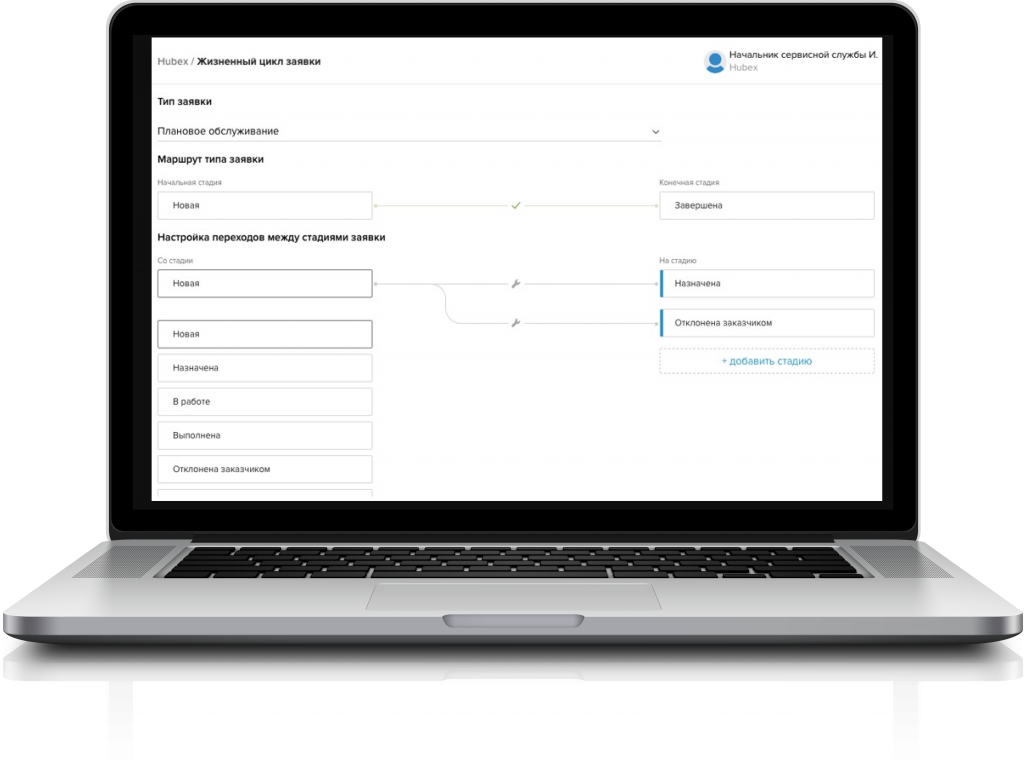
Setting the application life cycle without programming
If you use a dispatch center (your own or outsourced call center) to receive applications from the customer, you should be aware of how often the real problem at the facility does not coincide with its description in the application, which arrives at the service company. As a result, a specialist of the wrong profile leaves the site, does not have the necessary spare parts, tools. This leads to additional equipment downtime, repeated visits, customer dissatisfaction, fines for untimely troubleshooting.
This problem can be solved in different ways: to train dispatchers, to replace them with highly qualified engineers is expensive and not always effective.
Our platform offers a different path - when accepting for service, the service company places a nameplate with a QR code on each piece of equipment. The QR code is the application template - it is enough for the customer to scan it using the mobile application, if necessary, attach photos and add comments, and the service company receives an application for specific equipment with a clear description of the problem. Our experience shows that such a solution in 80% of cases removes the problem of "damaged phone".
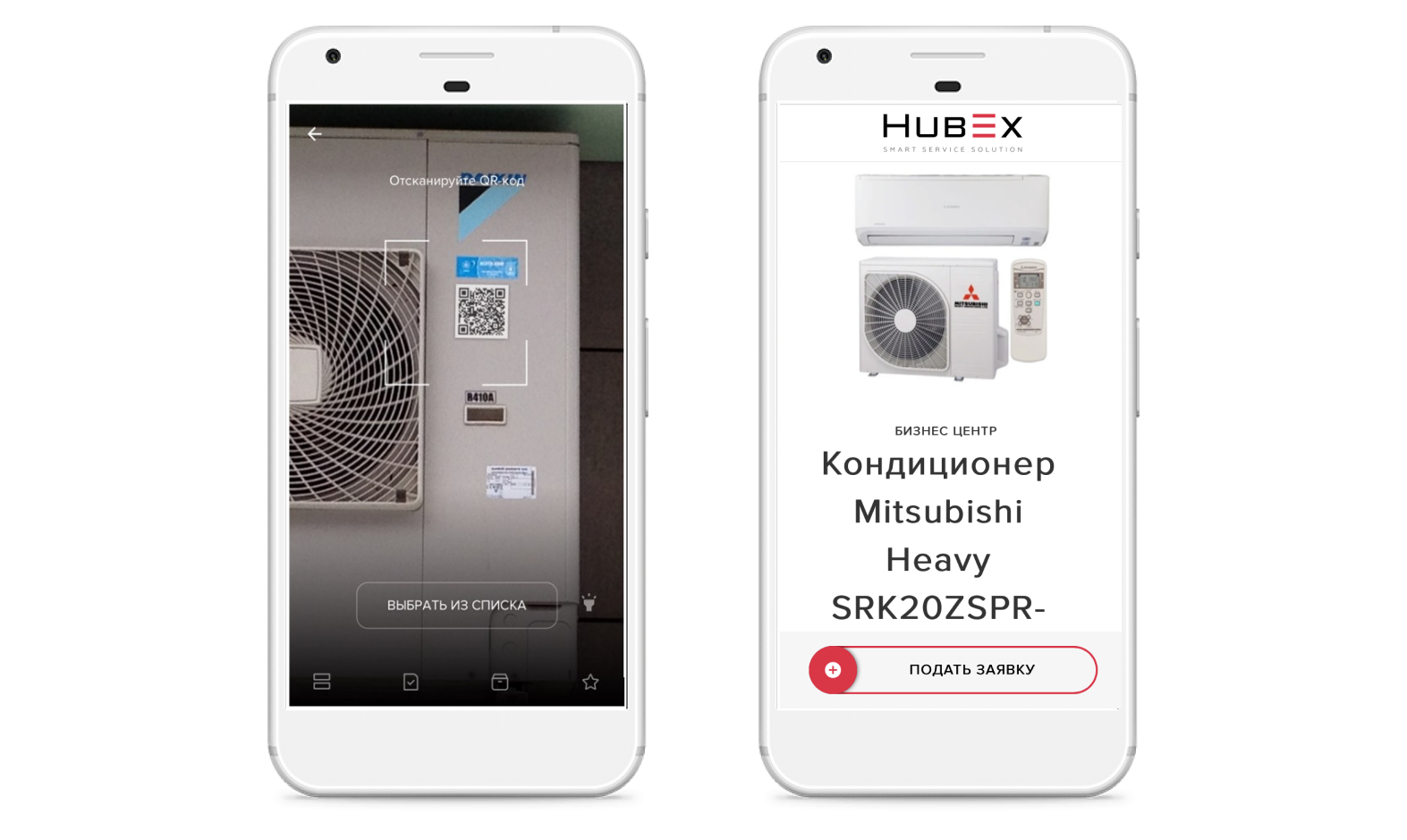
Filing an application by scanning the QR code of the equipment
When the number of mobile employees in your company exceeds 10 people, you begin to face the need for a tool to control their location. This is required for a wide range of tasks: accounting for working hours, monitoring fuel consumption, eliminating “trash” during working hours ... Today there are many solutions for this: trackers in cars, monitoring using mobile operators. They have a common drawback - the need to manually map data from multiple systems. This is a rather laborious and costly task.
In our platform, we implemented the following solution: at any change of an application by an employee in a mobile application, his geo-location is saved, photos in reports can only be downloaded using the camera (you can prevent photos from being added to the gallery) with saving the geodata and shooting date / time. This allows you to receive reports on the mismatch between the coordinates of the object and the place of registration of work performed, to compare the route of the employee with the work on applications.
There are also special filters and reports on the application, in which a geographical point is fixed during the execution of the application. In this way, the system indicates whether the work has been completed on site or outside the service facility.

Location of mobile employees on the map
Very often, work at customer sites requires compliance with certain regulations. This applies to safety, and the sequence of operations during the implementation of planned work. Solving this problem by writing a huge number of instructions for mobile employees is not always effective - there will always be a performer who has not read or forgot (and in our practice most of them are!). In HubEx, this problem is solved by setting up checklists (they can be linked to an object, specific equipment, or type of work). So, an employee always has before his eyes instructions on how to carry out work (a technological flow chart of operations), as well as the ability to fix equipment operation parameters, for example, meter readings.
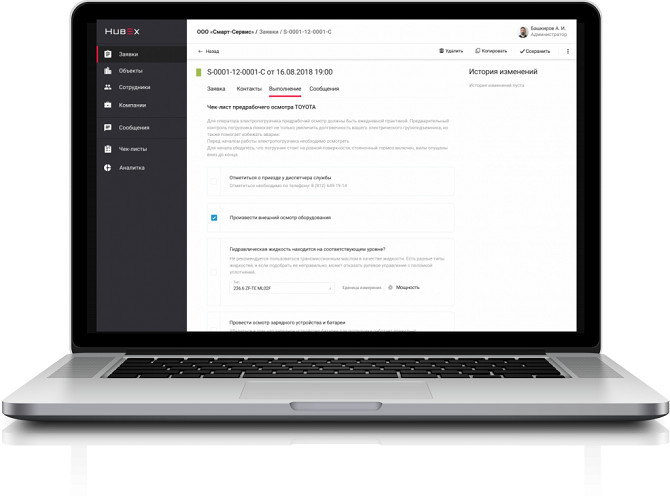
Setting up a checklist in HubEx
There are a large number of performance indicators of a service company. Many develop their own metrics. Collecting data for calculation often takes a lot of time and effort, and ends up analyzing them in Excel. At HubEx, we tried to make it possible to calculate the main indicators within the platform and present them in a convenient and understandable form in the integrated BI system. In addition, we have provided mechanisms for using external BI-solutions for data analytics (Power BI, Qlik and others).
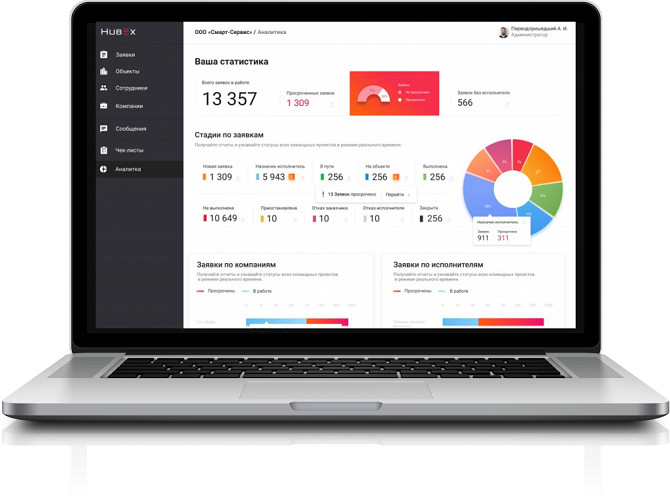
HubEx Dashboard
The information system must be flexible and dynamically adapt to current business requirements. The HubEx platform offers rich functionality for configuring customer service business processes by changing system settings and the application life cycle, but this may not be enough in some cases.
For self-expanding functionality, two options are offered: integration through the existing REST API, which provides full access to the system functions in accordance with the selected tariff plan, or the development of separate REST API system modules and refinement of the WEB user interface and mobile applications (available for on-premises solutions) . The ability to independently support and expand the functionality of the system allows you to reduce costs, time for implementation, as well as perform multilateral integration with corporate systems
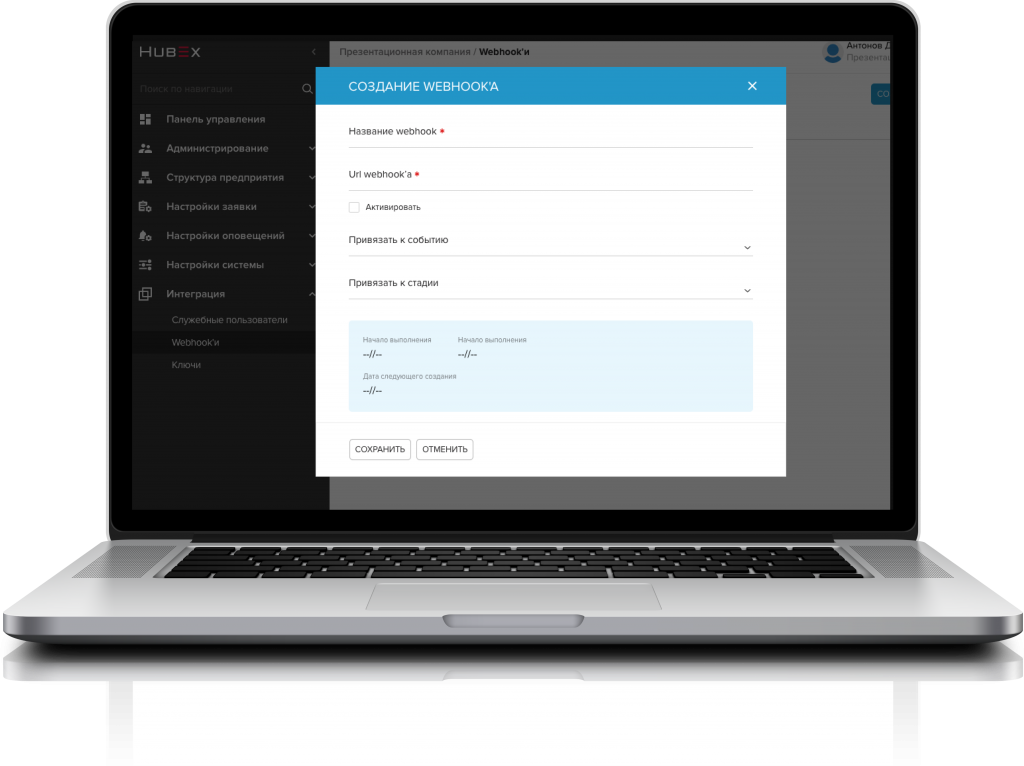
Webhook setup
The fact that you opened this article indicates that you already agree with the thesis: “Without an automation system, it is impossible to effectively manage a service company”. Now it remains to make a choice in favor of a platform convenient for your business.
We do not insist on choosing HubEx, but we are always ready to give you the opportunity to try the system for free. To do this, you can request 14 days of free access to HubEx.
Source: HubEx website
So a few years ago the idea came up to create a product that will solve our main problems - the HubEx platform. What did we manage to solve?
Problem 1. The system "out of the box" does not take into account the particular business
Any service business, even a small one, has its own characteristics. Sometimes they arise due to the specific requirements of customers, sometimes they are interesting ideas that give companies a competitive advantage. For the first time faced with the need to choose a system for automating service processes and managing mobile employees, we found that most of the solutions on the market do not allow us to implement our business processes. We had a choice:
- change our processes for a ready-made solution, sometimes losing the hard-won achievements;
- modify any solution for your processes. But we did not find a flexible platform with the ability to customize our business’s target process without the need to create a full stack development department, and success in this case was not guaranteed.
- write a management system for service and mobile employees from scratch, putting all our knowledge and experience into it.
We went the third way, but this story, perhaps, deserves a separate book. We will only say that developing a system from scratch proved to be many times more complicated and longer than we could imagine - it took 3 years to create a HubEx team of 20+ professionals, and it also required opening a separate IT company. Already at the beginning it became clear that developing a platform only for yourself is too expensive a process. Then we decided to develop a product that is suitable not only for us, but also for any service company on the market.
The main requirement for the platform was maximum flexibility and the ability to customize for any type of service business. The ability to create different types of applications, setting up a route for each type without programming, field visibility depending on the stage of the application, user rights and authorities, and much more, we managed to implement in our platform. To date, we have not met a service company whose business processes we would not have been able to implement on our platform without modifications. Even the processes of non-service companies, as it turned out, fit perfectly into the system. For example, the operation of commercial real estate, manufacturing enterprises, companies providing services (cleaning, security companies, logistics companies, etc.).

Setting the application life cycle without programming
Problem 2. “Spoiled phone”
If you use a dispatch center (your own or outsourced call center) to receive applications from the customer, you should be aware of how often the real problem at the facility does not coincide with its description in the application, which arrives at the service company. As a result, a specialist of the wrong profile leaves the site, does not have the necessary spare parts, tools. This leads to additional equipment downtime, repeated visits, customer dissatisfaction, fines for untimely troubleshooting.
This problem can be solved in different ways: to train dispatchers, to replace them with highly qualified engineers is expensive and not always effective.
Our platform offers a different path - when accepting for service, the service company places a nameplate with a QR code on each piece of equipment. The QR code is the application template - it is enough for the customer to scan it using the mobile application, if necessary, attach photos and add comments, and the service company receives an application for specific equipment with a clear description of the problem. Our experience shows that such a solution in 80% of cases removes the problem of "damaged phone".

Filing an application by scanning the QR code of the equipment
Problem 3. Where are my employees and what are they doing?
When the number of mobile employees in your company exceeds 10 people, you begin to face the need for a tool to control their location. This is required for a wide range of tasks: accounting for working hours, monitoring fuel consumption, eliminating “trash” during working hours ... Today there are many solutions for this: trackers in cars, monitoring using mobile operators. They have a common drawback - the need to manually map data from multiple systems. This is a rather laborious and costly task.
In our platform, we implemented the following solution: at any change of an application by an employee in a mobile application, his geo-location is saved, photos in reports can only be downloaded using the camera (you can prevent photos from being added to the gallery) with saving the geodata and shooting date / time. This allows you to receive reports on the mismatch between the coordinates of the object and the place of registration of work performed, to compare the route of the employee with the work on applications.
There are also special filters and reports on the application, in which a geographical point is fixed during the execution of the application. In this way, the system indicates whether the work has been completed on site or outside the service facility.

Location of mobile employees on the map
Problem 4. How to ensure the implementation of work regulations?
Very often, work at customer sites requires compliance with certain regulations. This applies to safety, and the sequence of operations during the implementation of planned work. Solving this problem by writing a huge number of instructions for mobile employees is not always effective - there will always be a performer who has not read or forgot (and in our practice most of them are!). In HubEx, this problem is solved by setting up checklists (they can be linked to an object, specific equipment, or type of work). So, an employee always has before his eyes instructions on how to carry out work (a technological flow chart of operations), as well as the ability to fix equipment operation parameters, for example, meter readings.

Setting up a checklist in HubEx
Problem 5. Where are we now and where are we going?
There are a large number of performance indicators of a service company. Many develop their own metrics. Collecting data for calculation often takes a lot of time and effort, and ends up analyzing them in Excel. At HubEx, we tried to make it possible to calculate the main indicators within the platform and present them in a convenient and understandable form in the integrated BI system. In addition, we have provided mechanisms for using external BI-solutions for data analytics (Power BI, Qlik and others).

HubEx Dashboard
The information system must be flexible and dynamically adapt to current business requirements. The HubEx platform offers rich functionality for configuring customer service business processes by changing system settings and the application life cycle, but this may not be enough in some cases.
For self-expanding functionality, two options are offered: integration through the existing REST API, which provides full access to the system functions in accordance with the selected tariff plan, or the development of separate REST API system modules and refinement of the WEB user interface and mobile applications (available for on-premises solutions) . The ability to independently support and expand the functionality of the system allows you to reduce costs, time for implementation, as well as perform multilateral integration with corporate systems

Webhook setup
The fact that you opened this article indicates that you already agree with the thesis: “Without an automation system, it is impossible to effectively manage a service company”. Now it remains to make a choice in favor of a platform convenient for your business.
We do not insist on choosing HubEx, but we are always ready to give you the opportunity to try the system for free. To do this, you can request 14 days of free access to HubEx.
Source: HubEx website
All Articles